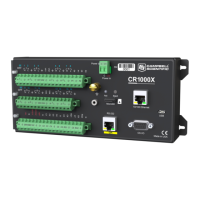NOTE:
Take precautions against ground loops when measuring sensors that require ac excitation.
See also Minimizing ground loop errors (p. 121).
For more information, see .
6.3.4 Accuracy for resistance measurements
Consult the following technical papers for in-depth treatments of several topics addressing
voltage measurement quality:
l Preventing and Attacking Measurement Noise Problems
l Benefits of Input Reversal and Excitation Reversal for Voltage Measurements
l Voltage Measurement Accuracy, Self- Calibration, and Ratiometric Measurements
NOTE:
Error discussed in this section and error-related specifications of the CR1000X do not include
error introduced by the sensor, or by the transmission of the sensor signal to the datalogger.
For accuracy specifications of ratiometric resistance measurements, see Resistance measurements
specifications (p. 168). Voltage measurement is variable V
1
or V
2
in Resistance measurements (p.
63). Offset is the same as that for simple analogue voltage measurements.
Assumptions that support the ratiometric-accuracy specification include:
l Datalogger is within factory calibration specification.
l Input reversal for differential measurements and excitation reversal for excitation voltage
are within specifications.
l Effects due to the following are not included in the specification:
o
Bridge-resistor errors
o
Sensor noise
o
Measurement noise
6.4 Thermocouple Measurements
Thermocouple measurements are special case voltage measurements.
NOTE:Thermocouples are inexpensive and easy to use. However, they pose several challenges
to the acquisition of accurate temperature data, particularly when using external reference
junctions.
A thermocouple consists of two wires, each of a different metal or alloy, joined at one end to
form the measurement junction. At the opposite end, each wire connects to terminals of a
6. Measurements 69

